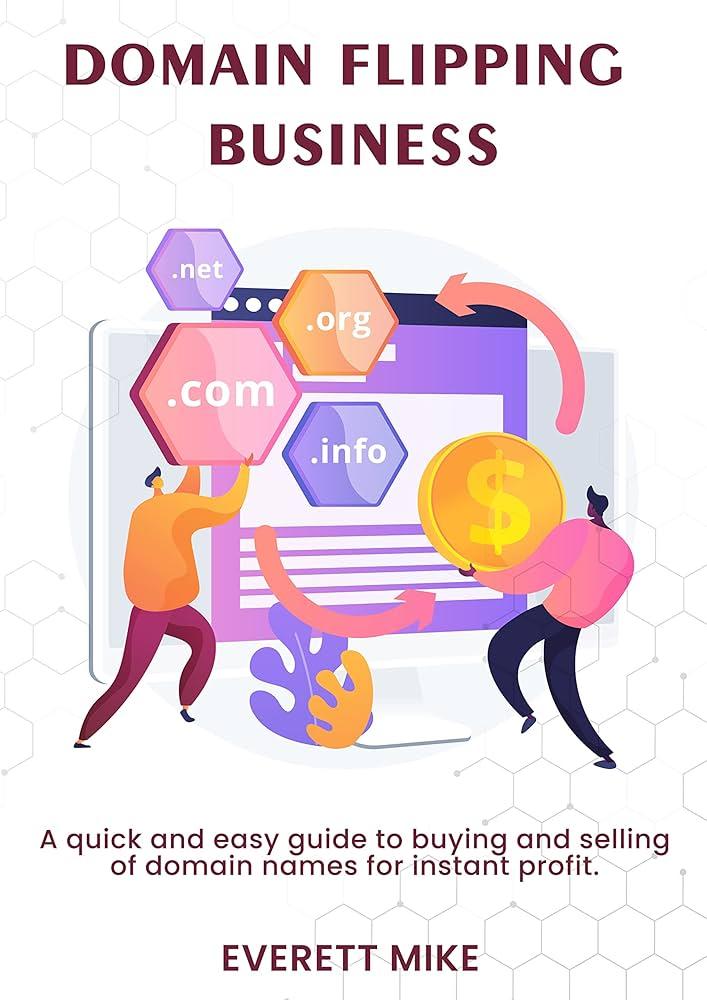Table of Contents
- Understanding the Basics of Domain Flipping and Its Profitable Potential
- Identifying Valuable Domains: Key Factors for Success
- Effective Strategies for Buying and Reselling Domains
- Marketing Techniques to Boost Your Domain Sales
- Common Mistakes to Avoid in Domain Flipping for New Investors
- Q&A
- Closing Remarks


Understanding the Basics of Domain Flipping and Its Profitable Potential
Domain flipping is an intriguing venture that blends creativity with investment savvy. At its core, domain flipping involves purchasing internet domain names at a low price with the intention of selling them at a higher price later. This practice hinges on identifying domains that have potential value for businesses, entrepreneurs, or anyone looking to establish an online presence. The demand for premium domain names is driven by the increasing need for brand visibility and online marketing, making this a potentially lucrative endeavor.
To succeed in domain flipping, it’s essential to understand what makes a domain valuable. Here are some key factors to consider:
- Length: Shorter domains tend to be more memorable and easier to brand.
- Keywords: Domains containing popular keywords can attract more traffic.
- Extensions: .com domains often hold more value than others, but don’t overlook niche-specific extensions.
- Market Trends: Staying up-to-date with industry trends can help you spot opportunities for valuable domain names.
Once you’ve identified a promising domain, it’s crucial to employ effective marketing strategies to increase its visibility. Consider creating dedicated landing pages that showcase the domain’s potential. You can leverage social media platforms and online forums to reach target audiences actively seeking attractive domain names. Additionally, joining domain flipping marketplaces can expand your ability to connect with potential buyers. Below is a simple table highlighting some popular marketplaces to consider:
| Marketplace | Features | Fees |
|---|---|---|
| Flippa | User-friendly, bidding options | Varies by sale price |
| Sedo | Global reach, domain auctions | 5-20% commission |
| GoDaddy Auctions | Large audience, trusted platform | Listing fees apply |


Identifying Valuable Domains: Key Factors for Success
When embarking on the journey of buying and selling domain names, understanding the key traits that contribute to a domain’s value is essential. Keywords play a vital role; domains featuring popular or relevant keywords can attract a more extensive audience. For instance, a domain name like bestfitnessgear.com could be more appealing compared to xzy123.com due to its clear association with a trending niche. Additionally, consider the length of the domain. Short, memorable names are often more valuable, as they are easier to recall and share.
The domain extension also has significant implications for its valuation. While .com domains are generally viewed as the most desirable due to their universal recognition, other extensions like .net, .org, .co, and even niche-specific extensions like .tech or .design are gaining traction. Moreover, think about the history of the domain. A domain that has a clean record, often free of penalties or spam associations, is more likely to fetch a high price in the resale market. Reputable history can also stimulate buyer confidence during negotiations.
assess the market demand for particular niches. Domains related to trending industries, like e-commerce, tech startups, or health and wellness, have massive potential for appreciation. Researching existing listings on domain marketplaces can provide insights into what buyers are currently seeking. Additionally, engaging with online forums and social media groups focused on domain flipping can yield valuable feedback and trends, helping you to identify promising opportunities effectively.
Effective Strategies for Buying and Reselling Domains
To excel in the domain flipping business, it’s crucial to conduct thorough research before purchasing any domain name. Begin by identifying trends in specific industries or niches that are currently in demand. Utilize tools like Google Trends and keyword research tools to find popular search terms. This will allow you to invest in domains that have high potential for future resale. Additionally, consider the length and memorability of the domain; shorter, catchy names are typically more desirable and easier to sell.
Once you have a potential domain in mind, assess its value. This can be done through various online appraisal tools or by analyzing similar domains that have sold recently. Look for factors such as the domain’s age, keyword relevance, and existing backlinks. Ensuring that the domain has a clean history—free from penalties or negative associations—is also important. Here’s a quick guide for evaluating domain names:
| Evaluation Factor | Description |
|---|---|
| Domain Length | Shorter domains (1-2 words) are more valuable. |
| Keyword Presence | Includes popular keywords for better visibility. |
| Domain Age | Older domains are often perceived as more credible. |
| Market Demand | Evaluate interest in related keywords and industries. |
After purchasing a domain, enhancing its appeal can significantly increase its resale value. Consider improving its SEO performance by developing a simple website or landing page, ensuring it’s well-optimized for search engines. You might also choose to build a social media presence related to the domain to generate organic traffic. Furthermore, investing in marketing strategies, such as showcasing the domain in online marketplaces, can directly attract potential buyers. Always keep an eye on the market trends, as being adaptable will aid you in selling the domain at the right time for maximum profit.


Marketing Techniques to Boost Your Domain Sales
To effectively enhance your domain sales, implementing smart marketing strategies is crucial. One effective technique is leveraging social media platforms. By promoting your domains on platforms such as Facebook, Twitter, and LinkedIn, you can reach a broader audience. Consider creating engaging posts that highlight the potential uses of the domains you’re selling, such as branding opportunities or SEO advantages. Utilize hashtags related to domain sales and entrepreneurship to further increase visibility.
Another impactful approach is to engage with niche communities and forums that focus on domain investments or entrepreneurship. Participating in discussions on platforms like Reddit or specialized forums can not only position you as an expert but also connect you with potential buyers. When sharing your listings, remember to focus on the value each domain provides. Highlight features such as domain age, keyword relevance, and traffic statistics to attract serious buyers.
consider utilizing email marketing by building a targeted list of subscribers interested in acquiring domains. Crafting informative newsletters or promotional emails that showcase available domains along with their unique selling propositions can significantly boost your conversion rates. Including testimonials from previous buyers and case studies about successful domain flips can add credibility and entice prospective customers.


Common Mistakes to Avoid in Domain Flipping for New Investors
When diving into domain flipping, new investors often fall into common pitfalls that can derail their efforts. One significant mistake is underestimating the importance of thorough research. Many newcomers make impulsive purchases without checking the domain’s history, potential market demand, or existing competition. It’s crucial to investigate factors such as search volume, trending keywords, and domain age to ensure that the investment has potential for appreciation.
Another frequent error is overpaying for domains. While a catchy or brandable domain might seem worth the cost, it’s essential to set a budget and stick to it. Many new flippers get caught up in bidding wars or emotional buys. Implementing a strict valuation model can help maintain objectivity and prevent overspending. Consider using metrics such as Google Trends and tools like SEMrush or Ahrefs to assess a domain’s value before making any purchase.
Lastly, neglecting marketing after acquiring a domain is a major mistake that can hinder profit. New investors often expect their domain to sell quickly without putting in the effort to promote it. An effective strategy includes listing the domain on various marketplaces, creating a compelling landing page, and utilizing social media to create awareness. By actively marketing the domain, investors can significantly increase their chances of a successful flip.
Q&A
Q&A: Understanding Domain Flipping
Q1: What is domain flipping? A1: Domain flipping is the practice of buying domain names at a low price and then selling them at a significantly higher price. It’s akin to real estate investing, but instead of properties, you’re trading digital assets. Successful domain flippers identify and acquire domains with potential value, then seek buyers willing to pay a premium for them.Q2: How does one determine the value of a domain name? A2: The value of a domain name can be influenced by several factors, including its length, keyword relevance, market trends, and brandability. Short, memorable names that contain popular keywords or phrases generally command higher prices. Tools like domain appraisal services can also provide insights into a domain’s potential worth.
Q3: Where can I buy domains for flipping? A3: Domains can be purchased from various platforms, including registrars like GoDaddy and Namecheap, as well as auction sites like Sedo and Flippa. Some flippers also buy domains directly from individuals or at liquidation sales where unregistered domains are made available to the public.
Q4: What are the risks associated with domain flipping? A4: Like any investment, domain flipping comes with risks. You may not be able to sell the domain for a profit, or it could take a long time to find buyers. Furthermore, trends change rapidly, so a domain that seems valuable today may become less desirable tomorrow. It’s essential to conduct thorough research before investing.
Q5: Can anyone get started in domain flipping? A5: Absolutely! Domain flipping is accessible to anyone with an interest in digital marketing and a bit of starting capital. However, success requires knowledge and strategic decision-making. Beginners should educate themselves on market trends, keyword research, and domain valuation to maximize their potential.
Q6: What are some tips for successful domain flipping? A6: Here are a few essential tips:
- Research Popular Trends: Identify sectors that are currently trending; these domains will likely attract buyers.
- Stay Brandable: Choose domains that are easy to spell and remember, appealing to businesses looking for online presence.
- Be Patient: Flipping domains can take time. Don’t rush the sale; wait for the right buyer.
- Network and Market: Join forums and groups related to domain flipping to increase visibility and sell more effectively.
Q7: Is there a difference between domain flipping and domain investing? A7: While the terms are sometimes used interchangeably, domain flipping usually refers to the short-term buy-and-sell strategy, whereas domain investing encompasses a broader long-term strategy where domains are held for a longer period, often for appreciation or development into websites. Investors typically look for sustainable revenue-generating domains, while flippers focus on quick turnovers.
Q8: Where can I learn more about domain flipping? A8: Various online resources can provide invaluable information about domain flipping. Websites like DomainSherpa and various domain investing forums can offer insights, tips, and community support. Additionally, books and courses on digital marketing and domain investment strategies can further enhance your knowledge.—This Q&A aims to provide you with a foundational understanding of domain flipping and guide you on your journey in this intriguing niche of internet entrepreneurship. Whether you’re just starting or looking to refine your tactics, this dynamic field offers plenty of opportunities for those willing to learn and adapt.

